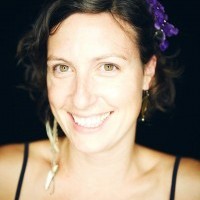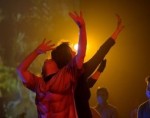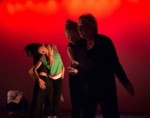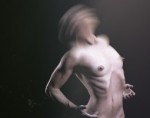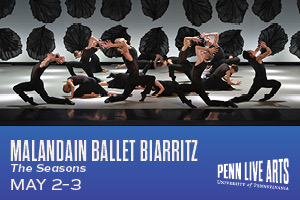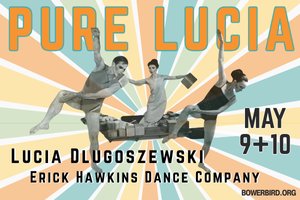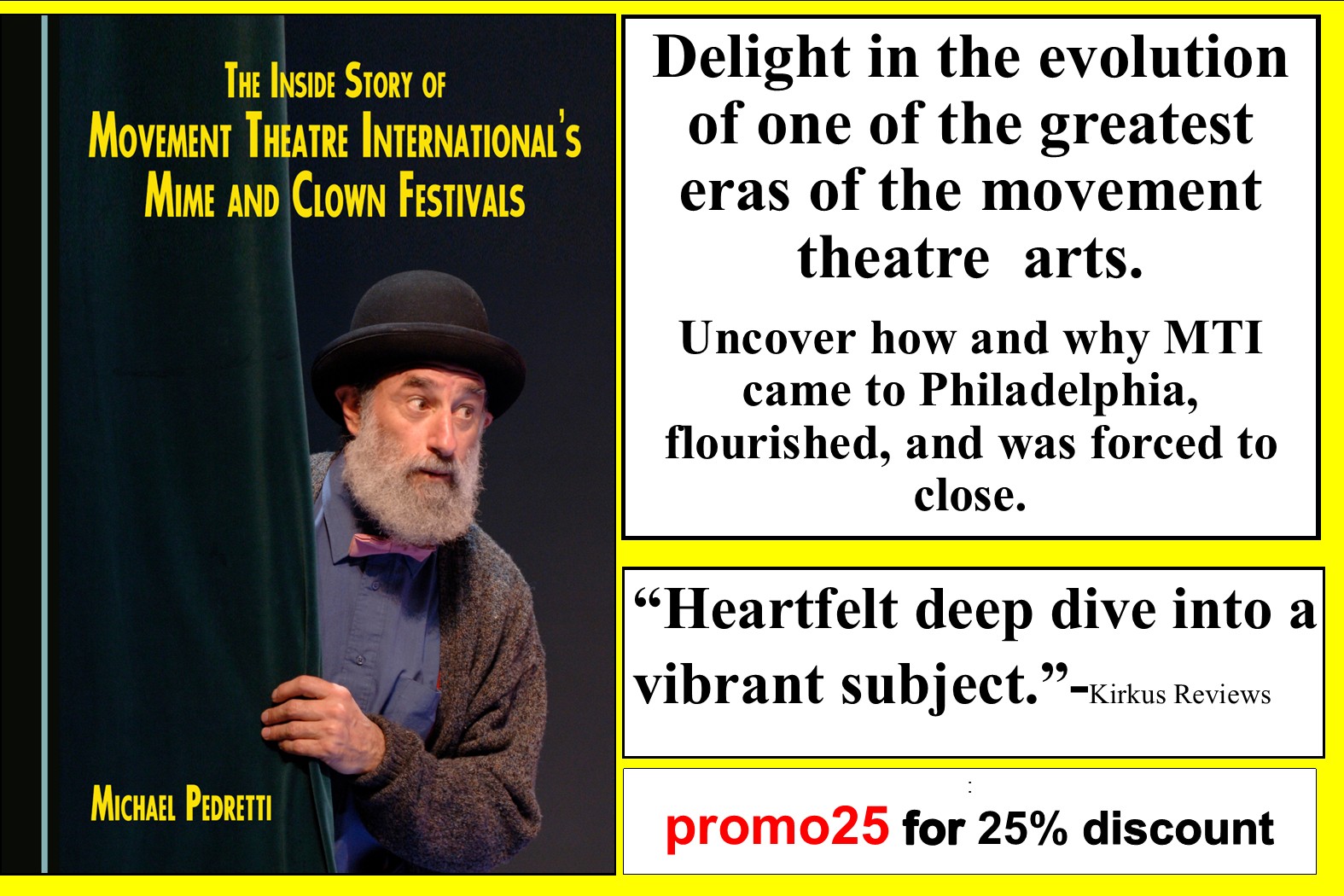
Photo: Tayarisha Poe
A Dance of Attention
by Megan Bridge
In the first weekend of May at Headlong Studios, Move Dance Think Fest (the Significance of Everything: A Way Into Presence) spanned two full days of workshops, performances, lectures, and conversation. The two performances I attended on Saturday were bridged by a lecture on presence by Headlong Dance Theater’s David Brick. I’ve had a lot of conversations with David about our shared interest in presence over the years, so it was exciting to be in attendance at this lecture, where he welcomed push back from the audience, admitting that this was his “first attempt to trundle out a lot of the things that motivate me in my artistic practice.” David dreams of “a fundamentally different dance world” which places less value on “training that is based in mastery of style” and moves “toward a goal of a more intelligent and diverse body.” His larger goal is to “introduce practices of presence into a much broader spectrum of everyone’s life: arts practitioners and lay people.”
But why? What exactly is David so concerned with, what does he
mean when he talks about presence? Stage presence? Acting? Charisma? Is this just another buzzword on the fringes of the dance scene? No! The
metaphysics of presence is a huge area of inquiry that philosophers from Aristotle to Heidegger to Derrida have grappled with for centuries, and a topic that has been readily taken up by dance and performance studies for the last few decades, as well.
Some definitions
The first
definition of presence that appears in a Google search gives a bit of a clue as to why it is such a vast topic. “Presence (noun): the state or fact of existing, occurring, or being present in a place or thing.” But this “being present” need not be physical; smell, memory, or a picture may all conjure the presence of the deceased or an absent loved one. Performance studies scholar
Peggy Phelan writes about watching her friend gradually slip away into a coma from which she would never wake, and perceiving the yawning gap there between presence and death.
[1] Presence does not necessarily equal body, or embodiment. We know we can be present in something without physically being there, we can feel the presence of something without experiencing its material manifestation before us. And, conversely, through imagination, memory, longing, regret, our presence can travel far away from the space and time that our physical body occupies.
André Lepecki proposes that Western dance history is predicated on the very gap between “presence” and “body.” Early texts on choreography (like
Feuillet’s from 1701) depend on the idea of an abstract, or absent, body to codify and inscribe movement using drawings and figures. Much of dance education today is still unspooling that project: matching the physical body to an ideal posture, an abstract image. The contemporary dancing body is a site where all of these ideas tangle together, as Lepecki puts it, a “bridge between presence and embodiment.”
[2]
In David Brick’s lecture, “A Choreography of Presence,” he offered some particularly cogent working definitions of the concept of “presence” as we might encounter it in the actual practice of performance:
-Presence is the intentional transparency of directed consciousness
-Presence is the quality of a performer that brings our attention to the wider world, not just the explicit or surface content of a performance
-Working with presence involves paying attention to more registers of information and the senses that deliver that information
Performance, Peggy Phelan writes, takes place “in a maniacally charged present—and disappears into memory…”
[3] But what makes that “present” so charged? I believe it is “presence,” or the directed consciousness of the performer. But the audience has to cultivate a certain presence, too, has to be willing to plunge into a liminal space. A dance of attention.
[4]
Tracing lineages of presence
David Brick tracked a split in the post-modernism of the dance world, nominating one branch as the group of “presence post-moderns” (some of these have been particularly influential to David’s own thinking, such as
Ishmael Houston-Jones,
Eiko and Koma, and
Deborah Hay) and the others as the “movement for movement’s sake” post-moderns. He bemoaned choreographers who initially foregrounded the “psychic stuff” in their choreography but “abandoned early work that was full of idiosyncrasy and idiosyncratic bodies in exchange for spectacular dancing and replaceable bodies that would succeed more readily in the dance world.” David got us up on our feet with an exercise that brought some of his points to life through shared experience. He verbally directed us to walk forward and backward, weaving around each other through the space, but also drew our attention to our consciousness, encouraging us to notice anxiety or discomfort. This active participation sparked many in the group to weigh in with their own thoughts on presence: some described their shift in attention from the current time to memories of classes that took place a decade ago in this same room. As a group we had a long discussion about the concept of “mastery,” and whether or not this drive, so prevalent in Western dance education, undermines explorations of presence. Towards the end of his allotted two hours (which flew by), David elaborated on how his own company, Headlong Dance Theater, has worked with presence, showing video of work and detailing a small subset of their approaches and results.
Deborah Hay asserts that consciousness is visible, and David elucidated. “If a performer’s attention is preoccupied with thoughts such as ‘did I do this right, does this look hot,’ then those thoughts become the content of the work.” Some choreographers create task-based movement (I’m thinking of the gestures and complicated blocking that director
David Gordon devises) so that the performers are preoccupied, allowing their presence to remain neutral and not over-acted, while they deliver their lines. Presence isn’t about acting, or charisma, it’s about directed and specific consciousness.
Certainly Headlong’s longevity (the company was founded in 1993) in the Philadelphia dance community has created a safe space for a lot of experimentation and play in areas that mainstream dance practices have devalued. With the advent of
Headlong Performance Institute, the company’s impact on the dance culture of Philadelphia and on creating a “community of inquiry,” as David called it, is even more observable. But the stage was set and the participants were ripened for this kind of activity much earlier, when Manfred Fischbeck, Brigitta Herrmann, and Helmut Gottschild brought their dance company, Group Motion, from Berlin to Philadelphia in 1968, injecting German Expressionism into the city’s dance scene.
Group Motion’s impact on the dance culture in Philadelphia stems from decades-long research and the development of a lineage that started in Germany at the
Mary Wigman school, where Herrmann and Gottschild were students. With no mirrors, “the goal of class was to experience the movement from the inside out rather than to impose an external ideal of placement or position on the body…”
[5] Rather than searching for ideal form, this modern dance pioneer focused on enriching the physicality and inner life of the whole person. In Wigman, we have a clear historical example of a choreographer who seems to have foregrounded that “psychic stuff,” favoring explorations of presence over the concept of mastery. Her training, never codified, encouraged “the retrieval and transformation of subconscious impulse…[and] was committed to the idea that dance training should serve the purpose of freeing the dancer in a process of individual discovery.”
[6] Holding to Wigman’s ideal of exploration, for almost 50 years Group Motion has played a major role in making Philadelphia particularly hospitable to the kind of future in dance that David Brick imagines.
Presence enacted
The first performance on the lineup when I arrived at Headlong for Move Dance Think Fest was an improvised duet by Nicole Bindler and Curt Haworth. Their performance was quiet. Many inconsequential movement events were woven together into a fabric that invited my close attention without demanding it.
In a wide lunge, with sneaky shifting feet, Nicole held the shape of her body and gradually shifted her position in space, her elbow stuck to, rubbing on her knee. Curt bounded into the space but an audience member’s cough took his attention, he joined the coughing observer and it became a coughing duet. The chairs were arranged in a simple circle, which Nicole and Curt exited and re-entered freely. They left the studio through the back door to the courtyard, and suddenly Nicole’s hand appeared, holding a pinecone perfectly framed by the window. They came back in. They perched side by side on the windowsill. She whispered to him, he whispered back. Birds twittered outside. Voices, presumably from a rehearsal in the next room, raised in a cheer.
In this performance, it all poured in. I was not dazzled by the movement, or the way they crafted time and space. But this was more than okay, I was totally with them. Their directed consciousness invited me in to a dance of attention. An internal landscape. Still life with presence. A portrait, framed by life outside.
Where we went next was worlds apart. Zornitsa Stoyanova, co-curator of Move Dance Think Fest with Jacelyn Biondo and Kristen Shahverdian, read a short statement from Danielle Currica, the next performer. In the Burlesque world, Danielle goes by the name “Sophie Sucre.” Her statement revealed her interest in “the intimacy of shared experience” and reminded us to enjoy ourselves. I thought this was a good reminder, as I looked around and wondered how some of my colleagues, whom I know to be deeply invested in gender politics and who are critical of the male gaze, would respond to Danielle’s pasties and g-string.
Danielle entered the space as James Brown’s “It’s a Man’s Man’s Man’s World” played on the stereo. In the break, we’d been asked to move our chairs into a semi-circle that delineated one corner of the room as performance area. Clip lights at our feet pointed into the space as Danielle entered, wearing a white female tuxedo and black stiletto heels. At first I was uncomfortable. Not because I don’t appreciate the form; in fact, I love Burlesque, and Danielle is one of the most skilled performers I’ve ever seen. I was really looking forward to this. But the context was so strange. I was sitting there with a notebook and pen, rather than a beer in my hand. There was no whooping and hollering.
Then, she began. Danielle works a lot with direct eye contact, her gaze invites and teases. She fully inhabits her movements, whether they are grand or subtle. Her precision, specificity, and facial expressions gradually drew me to the edge of my seat. Her slow removal of one black lace glove seemed to hold time suspended for a moment. The tiniest exhale made her shoulders twitch ever so slightly forward, while her rib cage sunk back and her chin lifted, baring her throat. She was playing with vulnerability and power in such complicated ways. There was some nervous giggling from the audience. Later on, she dove over the back of a folding chair, mostly bare ass and legs in the air. Then, suddenly, it was over. Zornitsa reappeared, fumbling her words a bit, admitting that her brain had been mushed around by what we all just experienced. I felt similarly. I think presence has something to do with this too.
This excellent, if very brief, performance was followed by a discussion, wherein Danielle spoke about the history and politics of Burlesque. I was glad the discussion came last: were it at the beginning I think the audience may have been over-analytical, and unable to take Danielle up on her suggestion to enjoy. Contextualizing the performance within this framework fully erased the discomfort I felt at the beginning, but also allowed me to own that discomfort as a learning experience. Sometimes, it’s all about the frame.
Jumatatu Poe capped off the evening with his solo work, Android Tears, a meditation on the proliferation of self and the slippery quality of identity. He wore his afro parted into three pigtails that exploded from his head, booty shorts (that we later learned, when he stripped to tie-dyed briefs, were padded both front and back), enormous platform boots, and a cluster of long pink ribbons wrapped around his neck and emerging from underneath his sheer jersey. Working with breath, text, and varied movement states (tumbling, running, repeated gesture sequences, long limbs reaching, extending, falling, throwing, leaping, thrusting his whole body through space), it seemed that nothing escaped this performer’s notice. He was utterly invested in his environment, both internal and external, and inhabited a veritable parade of different presences, so many versions of himself and fantastical imaginings of what that “self” could be. His many stories of self—one told huddled by a single nightlight plugged into the upstage wall, one told in virtuosic and rhythmic unison with a cell-phone recording of himself, one told by a “talking head” on an iPad held aloft in the dark—occupied an uncanny, liminal space between real and surreal. “This is my life. This is fiction. I am not here right now.” And, later, “I don’t know what love is, I don’t know what you is, I don’t know what I is, you can’t have me because I am not here.” Android Tears left me moved, baffled, delighted, and happily ruminating on questions of multiplicity, attention, time, memory, humanity, and…of course…presence.
It feels like an exciting time to be part of the experimental performance community in Philadelphia. Presence is something we’re concerned with, not just “performance presence” but presence with all of its attending questions about time, space, absence, death, birth, being. Dance is the site where we give ourselves to the asking of these questions, and we invite others into this liminal space to collectively wonder with us.
Move Dance Think Fest, Headlong Studios, May 2 & 3. www.movedancethink.org/
Notes:
1Peggy Phelan, “Trisha Brown’s
Orfeo: Two Takes on Double Endings” in
Of the Presence of the Body: Essays on Dance and Performance Theory, André Lepecki, ed. (Middletown, CT, Wesleyan University Press, 2004), 13-28
2André Lepecki, “Introduction: Presence and Body in Dance and Performance Theory” in
Of the Presence of the Body: Essays on Dance and Performance Theory, André Lepecki, ed. (Middletown, CT, Wesleyan University Press, 2004), 4
3Peggy Phelan,
Unmarked: The Politics of Performance (New York, Routledge, 1993), 148
4 “A dance of attention is not attentiveness of the human
to the environment but attentiveness
of the environment to its own flowering, at the very limit where experience and imagination, immediacy and cross-checking, overlap.” Erin Manning & Brian Massumi,
Thought in the Act: Passages in the Ecology of Experience (Minneapolis, University of Minnesota Press, 2014), 6
5Mary Anne Santos Newhall,
Mary Wigman (London, Routledge, 2009), 135-136
By Megan Bridge
May 14, 2015


